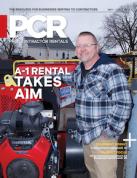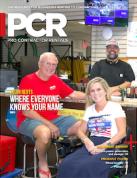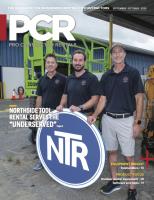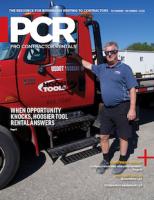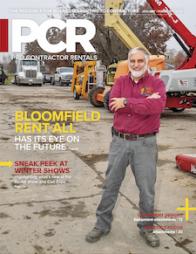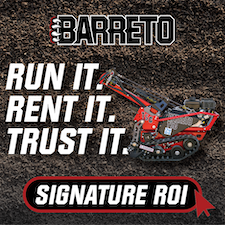Business Management -- Operator insight
Access control systems can help companies identify operator training needs.
by Jennifer Stiansen
A big challenge for rental companies is ensuring that customers are allowing only people with the right level of training to operate rented equipment. After all, most of the equipment on a job site is unsecured; if the keys are in it, anyone can use it.
“The typical construction site is not a neat, perfectly-orchestrated place,” says Ara Eckel, director of product management for JLG connected solutions. “Machines and workers are constantly moving, often across surfaces that are not perfectly level. That’s not an environment where untrained, unqualified operators should be operating heavy equipment.”
Rick Smith, JLG’s senior director of global product training, concurs. “Untrained operators can put themselves and other workers in danger,” he says, “and they also increase the odds of property and equipment damage.”
When accidents happen on construction sites, a company’s operational costs could go up to pay the fines from violations and to cover workers’ compensation claims. According to OSHA, the penalty for serious violations cost approximately $13,000 each; and the average cost of a workers’ comp claim is about $40,000, according to the National Safety Council.
That could add up to large unplanned, out-of-pocket expenses, especially in instances where fleet managers are already challenged by a skilled labor shortage and high employee turnover. “Today’s labor challenges are certainly a challenge,” says Smith, “but it’s no reason to have untrained or unqualified operators on machines.”
Access control to the rescue
How can a rental company help customers address the need for operator training more proactively? With technologies such as access control, renters and rental agencies can minimize the risk of equipment being operated by untrained individuals, says Eckel and Smith. Access control, in its most basic form, is a solution that can be programmed to grant a person access to a system or an area/location. Users already encounter access control every day, from unlocking cars and homes to gaining access to a parking garage or a hotel room.
With this understanding, it’s easy to see how access control can be applied to equipment fleets. It enables fleet managers to minimize the risk of unauthorized personnel accessing equipment by only granting access to employees qualified and approved to operate the machine.
How it works
Authorized machine operators receive a unique ID number or RFID card that allows them to access the equipment they are authorized to operate. The RFID cards, produced by the International Powered Access Federation (IPAF) and certain aerial lift manufacturers, including JLG, contain operator training data and a list of machine types he or she is qualified to operate when each qualification expires.
“RFID cards transform access control from a list of operator numbers and PIN codes into a knowledge system,” Eckel says. JLG provides operator training and RFID cards loaded with the corresponding qualifications to the individuals JLG trains. That integrated approach helps fleet owners simplify operator administration.
In addition, the RFID cards enable fleet owners, including rental companies, to track team member qualifications that need to be renewed. For example, OSHA considers telehandlers to be rough-terrain powered industrial trucks and it mandates that operators must be recertified every three years.
Other types of equipment such as aerial lifts, also known as mobile elevating work platforms (MEWPs), are governed by a voluntary set of standards. In the United States, these are ANSI standards that specify that operators must be qualified to operate a MEWP. Many fleet owners follow these standards to improve safety.
Access control can be managed via PIN code, an RFID card or both. Without proper authentication, the machine cannot be started or operated. It also allows operator tracking, which is an additional benefit.
In addition to granting operator access, access control, in combination with telematics data collected from the machine, can give fleet managers a more complete picture of who is using each machine and how.
“Currently, telematics systems report on basic equipment data: Location, whether or not the machine is operating and a limited amount of conditional data, such as hour meter readings. Imagine the possibilities when you expand that with access control to include data on how a machine is being used,” says Smith. For example, access control can track operational functions, like rotate, extend and drive to give managers an idea of basic machine usage functions.
Using access control to track an operator’s time in and out of the machine helps everyone involved get a better idea of machine utilization. “With traditional telematics functions, you can’t see who is operating a machine,” Eckel says. “Access control helps connect the dots by showing them who is operating each machine and when.” With this information, customers can do a more effective job managing both machines and workers.
“For example, if a daily inspection shows that a mobile aerial work platform was damaged, the access control system can tell you who was the last person who operated it,” Eckel adds.
Or it can tie an operator to certain diagnostic trouble code on the machine. For example, says Smith, if an operator is triggering a footswitch event many times if he or she is trying to make the machine function before pushing down the footswitch, that would indicate that more training, or at least some one-on-one coaching, may be needed.
“Extracting these meaningful data points from the equipment utilization reports allows rental managers to inform customers’ fleet managers that training to improve utilization and uptime may be needed.”
What’s coming next
Soon, it may even be possible for fleet managers to establish a profile of best operating practices and then compare that to the telematics data from each machine, says Smith. This could provide key insights into the true level of proficiency of each operator.
“For example,” Smith asks, “are the operators attempting to move the machine without using the proper interlocks? Are they exceeding the machine’s maximum slope capabilities? Is the machine generating alarms that indicate they’re pushing the limits of the machine’s capacity?”
Smith adds this data is already being captured on many electronic control systems, but as of now, they aren’t being reported by the telematics system. However, Smith is confident that they will be soon. Smith believes that once this detailed operating data is used, customers will wonder how they managed without it.
“It would enable you to provide customized training to improve performance in areas where operators may need help. You could even put operators in a virtual training environment where they could practice operations and procedures before getting into a physical machine,” Smith says.
The time has come
Even though these advanced training capabilities may be coming, rental companies and contractors can enjoy the benefits of access control today.
One driver of this trend is the growing number of countries adopting ISO standards for operator training and qualification. Smith, who sat on the committee that developed the ANSI A92 standard, explains that it was designed to align U.S. mobile elevating work platform standards with other regions’ industry standards. By doing so, it brought the access industry one step closer to global standardization.
“There’s no question that improved safety on job sites improves productivity. There’s a direct correlation. Making sure that only authorized users are operating equipment is a big part of that equation,” he concludes.
Jennifer Stiansen is director of marketing at JLG.
This article originally appeared in the January-February issue of Pro Contractor Rentals magazine ©2022 Urbain Communications LLC. All rights reserved.



